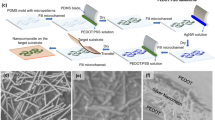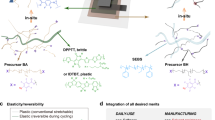Abstract
Large-scale integration of high-performance electronic components on mechanically flexible substrates may enable new applications in electronics, sensing and energy1,2,3,4,5,6,7,8. Over the past several years, tremendous progress in the printing and transfer of single-crystalline, inorganic micro- and nanostructures on plastic substrates has been achieved through various process schemes5,6,7,8,9,10. For instance, contact printing of parallel arrays of semiconductor nanowires (NWs) has been explored as a versatile route to enable fabrication of high-performance, bendable transistors and sensors11,12,13,14. However, truly macroscale integration of ordered NW circuitry has not yet been demonstrated, with the largest-scale active systems being of the order of 1 cm2 (refs 11,15). This limitation is in part due to assembly- and processing-related obstacles, although larger-scale integration has been demonstrated for randomly oriented NWs (ref. 16). Driven by this challenge, here we demonstrate macroscale (7×7 cm2) integration of parallel NW arrays as the active-matrix backplane of a flexible pressure-sensor array (18×19 pixels). The integrated sensor array effectively functions as an artificial electronic skin2,17,18, capable of monitoring applied pressure profiles with high spatial resolution. The active-matrix circuitry operates at a low operating voltage of less than 5 V and exhibits superb mechanical robustness and reliability, without performance degradation on bending to small radii of curvature (2.5 mm) for over 2,000 bending cycles. This work presents the largest integration of ordered NW-array active components, and demonstrates a model platform for future integration of nanomaterials for practical applications.
This is a preview of subscription content, access via your institution
Access options
Subscribe to this journal
Receive 12 print issues and online access
$259.00 per year
only $21.58 per issue
Buy this article
- Purchase on Springer Link
- Instant access to full article PDF
Prices may be subject to local taxes which are calculated during checkout





Similar content being viewed by others
References
Cao, Q. et al. Medium-scale carbon nanotube thin-film integrated circuits on flexible plastic substrates. Nature 454, 495–500 (2008).
Sekitani, T. et al. Organic nonvolatile memory transistors for flexible sensor arrays. Science 326, 1516–1519 (2009).
Cohen-Karni, T., Timko, B. P., Weiss, L. E. & Lieber, C. M. Flexible electrical recording from cells using nanowire transistor arrays. Proc. Natl Acad. Sci. USA 106, 7309–7313 (2009).
Fan, Z. et al. Three-dimensional nanopillar-array photovoltaics on low-cost and flexible substrates. Nature Mater. 8, 648–653 (2009).
McAlpine, M. C., Ahmad, H., Wang, D. & Heath, J. R. Highly ordered nanowire arrays on plastic substrates for ultrasensitive flexible chemical sensors. Nature Mater. 6, 379–384 (2007).
Park, S-I. et al. Printed assemblies of inorganic light-emitting diodes for deformable and semitransparent displays. Science 325, 977–981 (2009).
Rogers, J. A. & Huang, Y. A curvy, stretchy future for electronics. Proc. Natl Acad. Sci. USA 106, 10875–10876 (2009).
Yoon, J. et al. Ultrathin silicon solar microcells for semitransparent, mechanically flexible and microconcentrator module designs. Nature Mater. 7, 907–915 (2008).
Javey, A., Nam, S., Friedman, R. S., Yan, H. & Lieber, C. M. Layer-by-layer assembly of nanowires for three-dimensional, multifunctional electronics. Nano Lett. 7, 773–777 (2007).
Fan, Z. et al. Wafer-scale assembly of highly ordered semiconductor nanowire arrays by contact printing. Nano Lett. 8, 20–25 (2008).
Fan, Z., Ho, J. C., Jacobson, Z. A., Razavi, H. & Javey, A. Large scale, heterogeneous integration of nanowire arrays for image sensor circuitry. Proc. Natl Acad. Sci. USA 105, 11066–11070 (2008).
Takahashi, T. et al. Monolayer resist for patterned contact printing of aligned nanowire arrays. J. Am. Chem. Soc. 131, 2102–2103 (2009).
Yerushalmi, R., Jacobson, Z. A., Ho, J. C., Fan, Z. & Javey, A. Large scale, highly ordered assembly of nanowire parallel arrays by differential roll printing. Appl. Phys. Lett. 91, 203104 (2007).
Fan, Z. et al. Towards the development of printable nanowire electronics and sensors. Adv. Mater. 21, 3730–3743 (2009).
Qing, Q. et al. Nanowire transistor arrays for mapping neural circuits in acute brain slices. Proc. Natl Acad. Sci. USA 107, 1882–1887 (2010).
Ju, S. et al. Transparent active matrix organic light-emitting diode displays driven by nanowire transistor circuitry. Nano Lett. 8, 997–1004 (2008).
Someya, T. et al. A large-area, flexible pressure sensor matrix with organic field-effect transistors for artificial skin applications. Proc. Natl Acad. Sci. USA 101, 9966–9970 (2004).
Someya, T. et al. Conformable, flexible, large-area networks of pressure and thermal sensors with organic transistor active matrixes. Proc. Natl Acad. Sci. USA 102, 12321–12325 (2005).
Xiang, J. et al. Ge/Si nanowire heterostructures as high-performance field-effect transistors. Nature 441, 489–493 (2006).
Ford, A. C. et al. Diameter-dependent electron mobility of InAs nanowires. Nano Lett. 9, 360–365 (2009).
Acknowledgements
This work was partially financially supported by NSF CAREER Award, MARCO/MSD Focus Center and DARPA/DSO Programmable Matter. The synthesis part of this work was supported by a LDRD from Lawrence Berkeley National Laboratory. A.J. acknowledges support from the World Class University programme at Sunchon National University.
Author information
Authors and Affiliations
Contributions
K.T., T.T. and A.J. designed the experiments. K.T., T.T., A.G.G., J.C.H. and H.K. carried out experiments. K.T. and P.W.L. carried out simulations. K.T., T.T., P.W.L. and A.J. contributed to analysing the data. K.T. and A.J. wrote the Letter and all authors provided feedback.
Corresponding author
Ethics declarations
Competing interests
The authors declare no competing financial interests.
Supplementary information
Supplementary Information
Supplementary Information (PDF 403 kb)
Rights and permissions
About this article
Cite this article
Takei, K., Takahashi, T., Ho, J. et al. Nanowire active-matrix circuitry for low-voltage macroscale artificial skin. Nature Mater 9, 821–826 (2010). https://doi.org/10.1038/nmat2835
Received:
Accepted:
Published:
Issue Date:
DOI: https://doi.org/10.1038/nmat2835
This article is cited by
-
Device integration of electrochemical biosensors
Nature Reviews Bioengineering (2023)
-
Recent advances in flexible noninvasive electrodes for surface electromyography acquisition
npj Flexible Electronics (2023)
-
Van der Waals nanomesh electronics on arbitrary surfaces
Nature Communications (2023)
-
Localizing strain via micro-cage structure for stretchable pressure sensor arrays with ultralow spatial crosstalk
Nature Communications (2023)
-
Manufacturing of Highly Sensitive Piezoresistive Two-Substances Auxetic Strain Sensor Using Composite Approach
Fibers and Polymers (2023)



